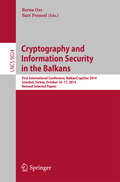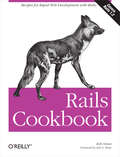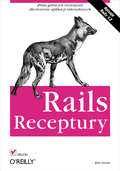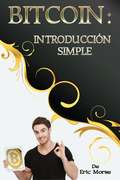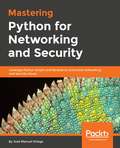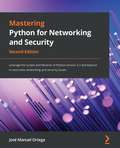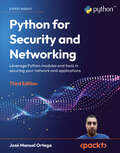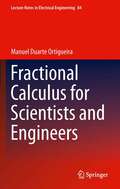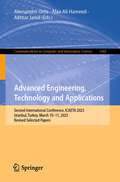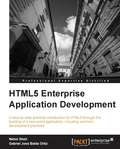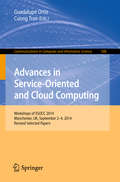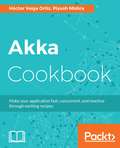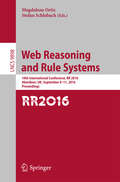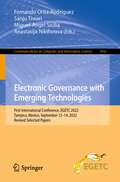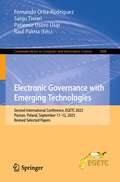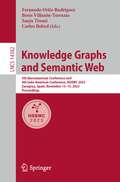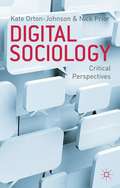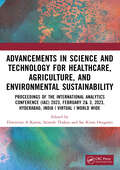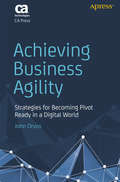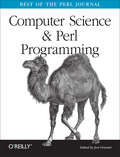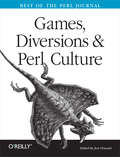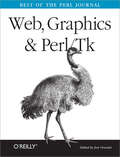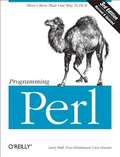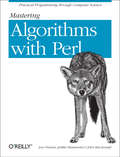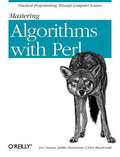- Table View
- List View
Cryptography and Information Security in the Balkans: First International Conference, BalkanCryptSec 2014, Istanbul, Turkey, October 16-17, 2014, Revised Selected Papers (Lecture Notes in Computer Science #9024)
by Berna Ors Bart PreneelThis book constitutes revised selected papers from the First International Conference on Cryptography and Information Security in the Balkans, Balkan Crypt Sec 2014, held in Istanbul, Turkey, in October 2014. The 15 papers presented in this volume were carefully reviewed and selected from 36 submissions. They were organized in topical sections named: symmetric cryptography, cryptographic hardware, cryptographic protocols and public key cryptography. The book also contains one invited talk in full paper length.
Rails Cookbook
by Rob OrsiniRails Cookbook is packed with the solutions you need to be a proficient developer with Rails, the leading framework for building the new generation of Web 2.0 applications. Recipes range from the basics, like installing Rails and setting up your development environment, to the latest techniques, such as developing RESTful web services. With applications that are code light, feature-full and built to scale quickly, Rails has revolutionized web development. The Rails Cookbook addresses scores of real-world challenges; each one includes a tested solution, plus a discussion of how and why it works, so that you can adapt the techniques to similar situations. Topics include: Modeling data with the ActiveRecord library Setting up views with ActionView and RHTML templates Building your application's logic into ActionController Testing and debugging your Rails application Building responsive web applications using JavaScript and Ajax Ensuring that your application is security and performs well Deploying your application with Mongrel and Apache Using Capistrano to automate deployment Using the many Rails plugins Working with graphics Whether you're new to Rails or an experienced developer, you'll discover ways to test, debug and secure your applications, incorporate Ajax, use caching to improve performance, and put your application into production. Want to get ahead of the Web 2.0 curve? This valuable cookbook will save you hundreds of hours when developing applications with Rails.
Rails. Receptury
by Rob OrsiniZbiór gotowych rozwišza? dla twórców aplikacji internetowych Instalacja i uruchomienie ?rodowiska Rails Przetwarzanie grafiki Korzystanie z technologii AJAX Dynamiczny rozwój sieci sprawia, ?e tradycyjne programy sš stopniowo wypierane przez aplikacje sieciowe dost?pne z poziomu przeglšdarki internetowej -- wygodne, niezale?ne od systemu operacyjnego i ?atwe w aktualizowaniu. Nadal jednak kluczowe znaczenie ma szybko?? ich przygotowywania i modyfikowania. Dzi?ki zbiorom bibliotek zwanym "frameworks" proces tworzenia takich produktów znacznie si? skróci? -- umo?liwia to programistom skoncentrowanie si? na faktycznej funkcjonalno?ci tworzonego narz?dzia, poniewa? biblioteki te przejmujš wiele typowych i wspólnych dla wszystkich aplikacji zada?. W?ród dost?pnych w sieci narz?dzi tego typu coraz wi?kszš popularno?? zyskuje Ruby on Rails, powoli stajšcy si? "ikonš" nurtu Web 2.0. Tworzone za jego pomocš systemy sš zwarte i ?atwe do skalowania, a ich kod ?ród?owy jest przejrzysty i czytelny. "Rails. Receptury" to zestaw porad i rozwišza? problemów, przed którymi stajš programi?ci stosujšcy ten zbiór bibliotek w swojej pracy. Omówione tu zagadnienia przydadzš si? zarówno poczštkujšcym, jak i do?wiadczonym twórcom aplikacji sieciowych. Przeczytasz tu o instalowaniu, konfigurowaniu i uruchamianiu ?rodowiska Rails, po?šczeniach z bazami danych za pomocš ActiveRecord, generowaniu kodu HTML, zabezpieczaniu programów i tworzeniu kontrolerów odpowiadajšcych za funkcjonalno?? systemu. Dowiesz si?, jak wdra?a? aplikacje Rails i korzysta? w nich z mo?liwo?ci oferowanych przez mechanizmy AJAX. Instalacja i uruchomienie ?rodowiska Komunikacja z bazami danych Wy?wietlanie danych w przeglšdarce Wykorzystywanie szablonów RHTML Generowanie kodu XML i RSS Przetwarzanie danych z formularzy Personalizacja narz?dzi Korzystanie z JavaScript i AJAX Zabezpieczanie aplikacji Rails Optymalizacja aplikacji Wdra?anie i utrzymywanie systemów na serwerach Przetwarzanie obrazów Skorzystaj ze sprawdzonych receptur i do?šcz do twórców Web 2.0!
Bitcoin: Introducción simple
by Esteban Lanza Ortega Eric MorseComprende los fundamentos de Bitcoin. Bitcoin es una revolucionaria divisa digital que está transformando el concepto de dinero que conocemos. Pero su comprensión puede ser intimidante para el usuario medio. ¡A partir de ahora dejará de serlo! Este libro elimina esta complejidad y enseña los fundamentos de Bitcoin de manera simple, con un lenguaje fácil de entender. No es un libro de texto. Es un primer contacto que responde a las más importantes y comunes preguntas que los nuevos usuarios tienen sobre Bitcoin. Sin jerga, sin tecnicismos y sin requerir conocimientos previos. En este libro encontrarás respuestas a preguntas como: ¿Qué es Bitcoin? ¿Qué lo hace tan especial? ¿Qué es el Blockchain? ¿Qué es la minería? ¿Quién controla Bitcoin? ¿Es Bitcoin seguro? ¿Es Bitcoin anónimo? ¿Cómo puedo usarlo de manera segura? ¿Debería invertir en Bitcoin? ¡…Y mucho más! ¡Y con este libro no te sentirás como si te estuvieran enseñando una lengua extranjera o un grado en ciencias de la computación! Prerrequisitos: ¡NINGUNO! Si alguna vez has comprado algo online, ya tienes lo que se necesita para entender este libro y aprender los fundamentos de Bitcoin.
Mastering Python for Networking and Security: Leverage Python scripts and libraries to overcome networking and security issues
by José Manuel OrtegaMaster Python scripting to build a network and perform security operationsKey FeaturesLearn to handle cyber attacks with modern Python scriptingDiscover various Python libraries for building and securing your networkUnderstand Python packages and libraries to secure your network infrastructureBook DescriptionIt’s becoming more and more apparent that security is a critical aspect of IT infrastructure. A data breach is a major security incident, usually carried out by just hacking a simple network line. Increasing your network’s security helps step up your defenses against cyber attacks. Meanwhile, Python is being used for increasingly advanced tasks, with the latest update introducing many new packages. This book focuses on leveraging these updated packages to build a secure network with the help of Python scripting. This book covers topics from building a network to the different procedures you need to follow to secure it. You’ll first be introduced to different packages and libraries, before moving on to different ways to build a network with the help of Python scripting. Later, you will learn how to check a network’s vulnerability using Python security scripting, and understand how to check vulnerabilities in your network. As you progress through the chapters, you will also learn how to achieve endpoint protection by leveraging Python packages along with writing forensic scripts. By the end of this book, you will be able to get the most out of the Python language to build secure and robust networks that are resilient to attacks.What you will learnDevelop Python scripts for automating security and pentesting tasksDiscover the Python standard library's main modules used for performing security-related tasksAutomate analytical tasks and the extraction of information from serversExplore processes for detecting and exploiting vulnerabilities in serversUse network software for Python programmingPerform server scripting and port scanning with PythonIdentify vulnerabilities in web applications with PythonUse Python to extract metadata and forensicsWho this book is forThis book is ideal for network engineers, system administrators, or any security professional looking at tackling networking and security challenges. Programmers with some prior experience in Python will get the most out of this book. Some basic understanding of general programming structures and Python is required.
Mastering Python for Networking and Security - Second Edition
by José Manuel OrtegaThis Python network security book is for network engineers, system administrators, or any security professional looking to overcome networking and security challenges. You will also find this book useful if you’re a programmer with prior experience in Python. A basic understanding of general programming structures and the Python programming language is required before getting started.
Python for Security and Networking: Leverage Python modules and tools in securing your network and applications, 3rd Edition
by Jose Manuel OrtegaGain a firm, practical understanding of securing your network and utilize Python's packages to detect vulnerabilities in your applicationKey FeaturesDiscover security techniques to protect your network and systems using PythonCreate scripts in Python to automate security and pentesting tasksAnalyze traffic in a network and extract information using PythonBook DescriptionPython's latest updates add numerous libraries that can be used to perform critical security-related missions, including detecting vulnerabilities in web applications, taking care of attacks, and helping to build secure and robust networks that are resilient to them. This fully updated third edition will show you how to make the most of them and improve your security posture.The first part of this book will walk you through Python scripts and libraries that you'll use throughout the book. Next, you'll dive deep into the core networking tasks where you will learn how to check a network's vulnerability using Python security scripting and understand how to check for vulnerabilities in your network – including tasks related to packet sniffing. You'll also learn how to achieve endpoint protection by leveraging Python packages along with writing forensics scripts.The next part of the book will show you a variety of modern techniques, libraries, and frameworks from the Python ecosystem that will help you extract data from servers and analyze the security in web applications. You'll take your first steps in extracting data from a domain using OSINT tools and using Python tools to perform forensics tasks.By the end of this book, you will be able to make the most of Python to test the security of your network and applications.What you will learnProgram your own tools in Python that can be used in a Network Security processAutomate tasks of analysis and extraction of information from serversDetect server vulnerabilities and analyze security in web applicationsAutomate security and pentesting tasks by creating scripts with PythonUtilize the ssh-audit tool to check the security in SSH serversExplore WriteHat as a pentesting reports tool written in PythonAutomate the process of detecting vulnerabilities in applications with tools like FuxploiderWho this book is forThis Python book is for network engineers, system administrators, and other security professionals looking to overcome common networking and security issues using Python. You will also find this book useful if you're an experienced programmer looking to explore Python's full range of capabilities. A basic understanding of general programming structures as well as familiarity with the Python programming language is a prerequisite.
Fractional Calculus for Scientists and Engineers
by Manuel Duarte OrtigueiraThis book gives a practical overview of Fractional Calculus as it relates to Signal Processing
Advanced Engineering, Technology and Applications: Second International Conference, ICAETA 2023, Istanbul, Turkey, March 10–11, 2023, Revised Selected Papers (Communications in Computer and Information Science #1983)
by Alessandro Ortis Alaa Ali Hameed Akhtar JamilThis book constitutes the Revised Selected Papers of the Second International Conference, ICAETA 2023, held in Istanbul, Turkey, during March 10–11, 2023.The 37 full papers included in this volume were carefully reviewed and selected from 139 submissions. The topics cover a range of areas related to engineering, technology, and applications. Main themes of the conference include, but are not limited to: Data Analysis, Visualization and Applications; Artificial Intelligence, Machine Learning and Computer Vision; Computer Communication and Networks; Signal Processing and Applications; Electronic Circuits, Devices, and Photonics; Power Electronics and Energy Systems.
HTML5 Enterprise Application Development
by Gabriel José Ortíz Nehal ShahA practical development tutorial, giving users step-by-step instructions to allow them to create an enterprise web application.This book is for developers who want to create enterprise web applications with engaging user experiences with no browser plugins. Basic JavaScript programming and knowledge of HTML and CSS is required. No knowledge of HTML5 or CSS3 is assumed.
Advances in Service-Oriented and Cloud Computing: Workshops of ESOCC 2014, Manchester, UK, September 2-4, 2014, Revised Selected Papers (Communications in Computer and Information Science #508)
by Guadalupe Ortiz Cuong TranThis volume contains the technical papers presented in the four high-quality workshops associated with the European Conference on Service-Oriented and Cloud Computing, ESOCC 2014, held in Manchester, UK, in September 2014: 4th International Workshop on Adaptive Services for the Future Internet, WAS4FI 2014, 2nd International Workshop on Cloud for IoT, CLIoT 2014, 2nd International Workshop on Cloud Service Brokerage, CSB 2014, and Seamless Adaptive Multi-cloud Management of Service-based Applications, SeaCloudS Workshop. The 19 revised full papers and 3 short papers were carefully reviewed and selected from 39 submissions. They focus on specific topics in service-oriented and cloud computing domains as cloud computing, service buses, Web services, service-oriented architectures, event-driven architectures, enterprise architectures, business process management, software selection and adaptation.
Akka Cookbook
by Hector Veiga Ortiz Piyush MishraLearn how to use the Akka framework to build effective applications in Scala About This Book • Covers a discussion on Lagom—the newest launched Akka framework that is built to create complex microservices easily • The recipe approach of the book allows the reader to know important and independent concepts of Scala and Akka in a seamless manner • Provides a comprehensive understanding of the Akka actor model and implementing it to create reactive web applications Who This Book Is For If you are a Scala developer who wants to build scalable and concurrent applications, then this book is for you. Basic knowledge of Akka will help you take advantage of this book. What You Will Learn • Control an actor using the ContolAware mailbox • Test a fault-tolerant application using the Akka test kit • Create a parallel application using futures and agents • Package and deploy Akka application inside Docker • Deploy remote actors programmatically on different nodes • Integrate Streams with Akka actors • Install Lagom and create a Lagom project In Detail Akka is an open source toolkit that simplifies the construction of distributed and concurrent applications on the JVM. This book will teach you how to develop reactive applications in Scala using the Akka framework. This book will show you how to build concurrent, scalable, and reactive applications in Akka. You will see how to create high performance applications, extend applications, build microservices with Lagom, and more. We will explore Akka's actor model and show you how to incorporate concurrency into your applications. The book puts a special emphasis on performance improvement and how to make an application available for users. We also make a special mention of message routing and construction. By the end of this book, you will be able to create a high-performing Scala application using the Akka framework. Style and approach This highly practical recipe-based approach will allow you to build scalable, robust, and reactive applications using the Akka framework.
Web Reasoning and Rule Systems
by Magdalena Ortiz Stefan SchlobachThis book constitutes the refereed proceedings of the 10th International Conference on Web Reasoning and Rule Systems, RR 2016, held in Aberdeen, Scotland, UK, in September 2016. The 10 full papers and 3 technical communications presented were carefully reviewed and selected from 17 submissions. Extensions and adaptations of classical rule-based languages have found their application in a range of areas, such as ontologies for the semantic web; querying web data; semantic data management; common-sense reasoning on the web
Electronic Governance with Emerging Technologies: First International Conference, EGETC 2022, Tampico, Mexico, September 12–14, 2022, Revised Selected Papers (Communications in Computer and Information Science #1666)
by Fernando Ortiz-Rodríguez Sanju Tiwari Miguel-Angel Sicilia Anastasija NikiforovaThis book constitutes selected and revised papers presented at the First International Conference on Electronic Governance with Emerging Technologies, EGETC 2022, held in Tampico, Mexico, in September 2022. The 15 full papers and 2 short papers presented were thoroughly reviewed and selected from the 54 submissions. This volume focuses on the recent developmentsin the domain of eGovernment and governance of digital organizations also aims to shed light on the emerging research trends and their applications.
Electronic Governance with Emerging Technologies: Second International Conference, EGETC 2023, Poznan, Poland, September 11–12, 2023, Revised Selected Papers (Communications in Computer and Information Science #1888)
by Fernando Ortiz-Rodríguez Sanju Tiwari Patience Usoro Usip Raul PalmaThis book constitutes the refereed proceedings of the Second International Conference on Electronic Governance with Emerging Technologies, EGETC 2023, held in Poznan, Poland, during September 11–12, 2023.The 15 full papers and one short paper presented were thoroughly reviewed and selected from the 76 submissions. This volume focuses on the recent developments in the domain of eGovernment and governance of digital organizations also aims to shed light on the emerging research trends and their applications.
Knowledge Graphs and Semantic Web: 5th Iberoamerican Conference and 4th Indo-American Conference, KGSWC 2023, Zaragoza, Spain, November 13–15, 2023, Proceedings (Lecture Notes in Computer Science #14382)
by Fernando Ortiz-Rodriguez Boris Villazón-Terrazas Sanju Tiwari Carlos BobedThis book constitutes the refereed proceedings of the 5th Iberoamerican Conference and 4th Indo-American Conference on Knowledge Graphs and Semantic Web, KGSWC 2023, held jointly in Zaragoza, Spain, during November 13–15, 2023.The 18 full and 2 short papers presented were carefully reviewed and selected from 50 submissions. They focus on the following topics: knowledge representation; natural language processing/text mining; and machine/deep learning research.
Digital Sociology
by Kate Orton-Johnson Nick PriorSociology and our sociological imaginations are having to confront new digital landscapes spanning mediated social relationships, practices and social structures. This volume assesses the substantive challenges faced by the discipline as it critically reassesses its position in the digital age.
Advancements in Science and Technology for Healthcare, Agriculture, and Environmental Sustainability: A Review of the Latest Research and Innovations
by Sai Kiran Oruganti Dimitrios A. Karras Srinesh ThakurThis book is the collection of selected articles that appeared at the First International Analytics Conference 2023 held in Hyderabad in virtual mode on February 2nd the 3rd 2023. This informative volume offers a window into recent breakthroughs shaping healthcare, agriculture, and environmental sustainability. It showcases the cutting-edge developments in these essential fields. Explore the progress in healthcare, from personalized medicine to telemedicine and innovative treatments, demonstrating how technology is enhancing patient care and transforming global health. Dive into the agricultural sector, where precision farming, genetic engineering, and sustainable practices are revolutionizing food production. Science and innovation play a key role in building a more resilient and food-secure future.
Achieving Business Agility: Strategies for Becoming Pivot Ready in a Digital World
by John OrvosKnow how to lead and establish business agility in your organization. Benefit from clear, actionable steps based on change management truths that have been long underutilized and have limited the success of agile expansion into your business. This book provides a pragmatic framework for leading your business toward shifting to an agile mindset. Achieving Business Agility offers strategies and concrete examples to engage business executives and will teach you how to effectively execute these strategies. Whether you are a delivery executive, a change advocate, a consultant, a business leader, or a newcomer to agile, you will learn clear actions from a practical, business-oriented perspective that is vital to effect change and bring agile into your business. The book is structured in three sections. The first provides you with a deep understanding of each of four strategies. The second section tells the story of a company that applied these strategies through the eyes of several key players. The last section helps you get started applying what you learned in your own company. What You’ll Learn Get the attention of your executives by alerting them to a company problem that can impact them personally and create a sense of urgency to address itCollaborate with your executives in a way that gets them to open up and to see how their operating model is a contributing cause to the company problemDemonstrate how your executives can specifically benefit from a new agile business operating model and address the company problemCreate a reinforcement structure on a larger scale to establish agile as the new standard operating model in your organization Who This Book Is For Managers, business leaders, and consultants at/for large enterprises or small startups who want their company to better compete in today’s fast-moving markets that present threats and opportunities at every turn. No agile expertise is required.
Computer Science & Perl Programming: Best of The Perl Journal
by Jon OrwantIn its first five years of existence, The Perl Journal ran 247 articles by over 120 authors. Every serious Perl programmer subscribed to it, and every notable Perl guru jumped at the opportunity to write for it. TPJ explained critical topics such as regular expressions, databases, and object-oriented programming, and demonstrated Perl's utility for fields as diverse as astronomy, biology, economics, AI, and games. The magazine gave birth to both the Obfuscated Perl Contest and the Perl Poetry contest, and remains a proud and timeless achievement of Perl during one of its most exciting periods of development. Computer Science and Perl Programming is the first volume of The Best of the Perl Journal, compiled and re-edited by the original editor and publisher of The Perl Journal, Jon Orwant. In this series, we've taken the very best (and still relevant) articles published in TPJ over its 5 years of publication and immortalized them into three volumes. This volume has 70 articles devoted to hard-core computer science, advanced programming techniques, and the underlying mechanics of Perl. Here's a sample of what you'll find inside:Jeffrey Friedl on Understanding Regexes Mark Jason Dominus on optimizing your Perl programs with Memoization Damian Conway on Parsing Tim Meadowcroft on integrating Perl with Microsoft Office Larry Wall on the culture of Perl Written by 41 of the most prominent and prolific members of the closely-knit Perl community, this anthology does what no other book can, giving unique insight into the real-life applications and powerful techniques made possible by Perl. Other books tell you how to use Perl, but this book goes far beyond that: it shows you not only how to use Perl, but what you could use Perl for. This is more than just The Best of the Perl Journal -- in many ways, this is the best of Perl.
Games, Diversions & Perl Culture: Best of the Perl Journal (Best of the Perl Journal)
by Jon OrwantThe Perl Journal (TPJ) did something most print journals aspire to, but few succeed. Within a remarkable short time, TPJ acquired a cult-following and became the voice of the Perl community. Every serious Perl programmer subscribed to it, and every notable Perl guru jumped at the opportunity to write for it. Back issues were swapped like trading cards. No longer in print format, TPJ remains the quintessential spirit of Perl--a publication for and by Perl programmers who see fun and beauty in an admittedly quirky little language. Games, Diversions, and Perl Culture is the third volume of The Best of the Perl Journal, compiled and re-edited by the original editor and publisher of The Perl Journal, Jon Orwant. In this series, we've taken the very best (and still relevant) articles published in TPJ over its 5 years of publication and immortalized them into three volumes. The 47 articles included in this volume are simply some of the best Perl articles ever written on the subjects of games, diversions, and the unique culture of this close-knit community, by some of the best Perl authors and coders. Games, Diversions & Perl Culture focuses on entertaining topics that make Perl users such fanatics about the language. You'll find all of the playful features TPJ offered over the years, including the Obfuscated Perl Contests, Perl Quiz Shows, humor articles, and renowned one-line recipes. The book also contains a panoply of quirky applications of Perl, including genetic algorithms, home automation, music programming, and an entire section on natural language processing. This anthology is an unmatched compendium of Perl lore.
Web, Graphics & Perl/Tk Programming
by Jon OrwantIn its first five years of existence, The Perl Journal (TPJ) became the voice of the Perl community. Every serious Perl programmer subscribed to it, and every notable Perl guru jumped at the opportunity to write for it. TPJ explained critical Perl topics and demonstrated Perl's utility for fields as diverse as astronomy, biology, economics, AI, and games. Back issues were hoarded, or swapped like trading cards. No longer in print format, The Perl Journal remains a proud and timeless achievement of Perl during one of its most exciting periods of development. Web, Graphics & Perl/Tk is the second volume of The Best of the Perl Journal, compiled and re-edited by the original editor and publisher of The Perl Journal, Jon Orwant. In this series, we've taken the very best (and still relevant) articles published in TPJ over its five years of publication and immortalized them into three volumes. The forty articles included in this volume are simply some of the best Perl articles ever written on the subjects of graphics, the Web, and Perl/Tk, by some of the best Perl authors and coders. Much of Perl's success is due to its capabilities for developing web sites; the Web section covers popular topics such as CGI programs, mod_perl, spidering, HTML parsing, security, and content management. The Graphics section is a grab bag of techniques, ranging from simple graph generation to ray tracing and real-time video digitizing. The Perl/Tk section shows you how to use the popular Perl/Tk toolkit for developing graphical applications that work on both Unix/Linux and Windows without a single change. Written by twenty-three of the most prominent and prolific members of the closely-knit Perl community, including Lincoln Stein, Mark-Jason Dominus, Alligator Descartes, and Dan Brian, this anthology does what no other book can, giving unique insight into the real-life applications and powerful techniques made possible by Perl.
Programming Perl
by Jon Orwant Tom Christiansen Larry WallPerl is a powerful programming language that has grown in popularity since it first appeared in 1988. The first edition of this book, Programming Perl, hit the shelves in 1990, and was quickly adopted as the undisputed bible of the language. Since then, Perl has grown with the times, and so has this book. Programming Perl is not just a book about Perl. It is also a unique introduction to the language and its culture, as one might expect only from its authors. Larry Wall is the inventor of Perl, and provides a unique perspective on the evolution of Perl and its future direction. Tom Christiansen was one of the first champions of the language, and lives and breathes the complexities of Perl internals as few other mortals do. Jon Orwant is the editor of The Perl Journal, which has brought together the Perl community as a common forum for new developments in Perl. Any Perl book can show the syntax of Perl's functions, but only this one is a comprehensive guide to all the nooks and crannies of the language. Any Perl book can explain typeglobs, pseudohashes, and closures, but only this one shows how they really work. Any Perl book can say that my is faster than local, but only this one explains why. Any Perl book can have a title, but only this book is affectionately known by all Perl programmers as "The Camel." This third edition of Programming Perl has been expanded to cover version 5.6 of this maturing language. New topics include threading, the compiler, Unicode, and other new features that have been added since the previous edition.
Mastering Algorithms with Perl: Practical Programming Through Computer Science
by Jon Orwant Jarkko Hietaniemi John MacdonaldMany programmers would love to use Perl for projects that involve heavy lifting, but miss the many traditional algorithms that textbooks teach for other languages. Computer scientists have identified many techniques that a wide range of programs need, such as: Fuzzy pattern matching for text (identify misspellings!) Finding correlations in data Game-playing algorithms Predicting phenomena such as Web traffic Polynomial and spline fitting Using algorithms explained in this book, you too can carry out traditional programming tasks in a high-powered, efficient, easy-to-maintain manner with Perl. This book assumes a basic understanding of Perl syntax and functions, but not necessarily any background in computer science. The authors explain in a readable fashion the reasons for using various classic programming techniques, the kind of applications that use them, and -- most important -- how to code these algorithms in Perl. If you are an amateur programmer, this book will fill you in on the essential algorithms you need to solve problems like an expert. If you have already learned algorithms in other languages, you will be surprised at how much different (and often easier) it is to implement them in Perl. And yes, the book even has the obligatory fractal display program. There have been dozens of books on programming algorithms, some of them excellent, but never before has there been one that uses Perl. The authors include the editor of The Perl Journal and master librarian of CPAN; all are contributors to CPAN and have archived much of the code in this book there. "This book was so exciting I lost sleep reading it." Tom Christiansen
Mastering Algorithms with Perl
by Jon Orwant Jarkko Hietaniemi John MacdonaldMany programmers would love to use Perl for projects that involve heavy lifting, but miss the many traditional algorithms that textbooks teach for other languages. Computer scientists have identified many techniques that a wide range of programs need, such as: Fuzzy pattern matching for text (identify misspellings!) Finding correlations in data Game-playing algorithms Predicting phenomena such as Web traffic Polynomial and spline fitting Using algorithms explained in this book, you too can carry out traditional programming tasks in a high-powered, efficient, easy-to-maintain manner with Perl. This book assumes a basic understanding of Perl syntax and functions, but not necessarily any background in computer science. The authors explain in a readable fashion the reasons for using various classic programming techniques, the kind of applications that use them, and -- most important -- how to code these algorithms in Perl. If you are an amateur programmer, this book will fill you in on the essential algorithms you need to solve problems like an expert. If you have already learned algorithms in other languages, you will be surprised at how much different (and often easier) it is to implement them in Perl. And yes, the book even has the obligatory fractal display program. There have been dozens of books on programming algorithms, some of them excellent, but never before has there been one that uses Perl. The authors include the editor of The Perl Journal and master librarian of CPAN; all are contributors to CPAN and have archived much of the code in this book there. "This book was so exciting I lost sleep reading it." Tom Christiansen
